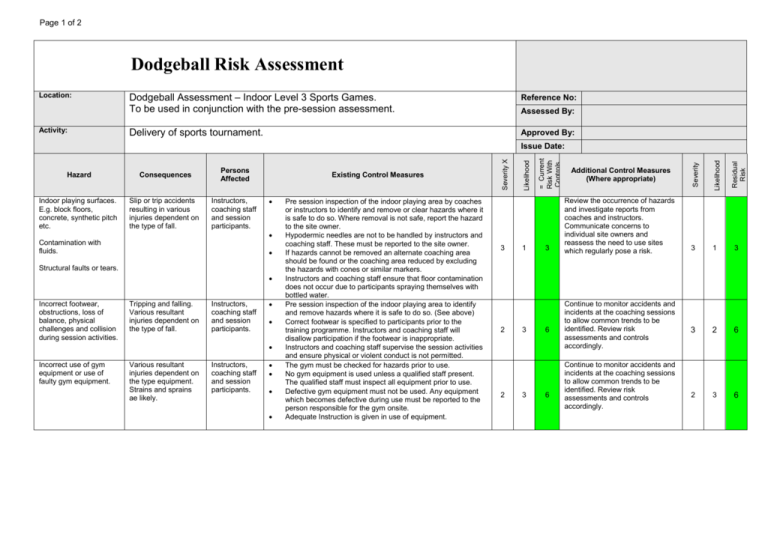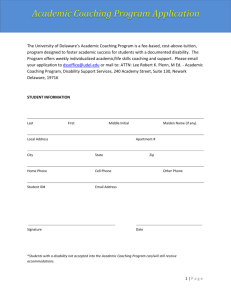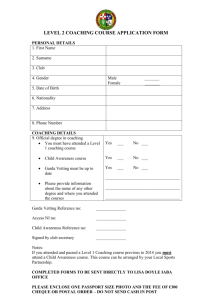Dodgeball Risk Assessment
advertisement

Page 1 of 2 Dodgeball Risk Assessment Location: Activity: Dodgeball Assessment – Indoor Level 3 Sports Games. To be used in conjunction with the pre-session assessment. Reference No: Delivery of sports tournament. Approved By: Assessed By: Instructors, coaching staff and session participants. Contamination with fluids. Structural faults or tears. Incorrect footwear, obstructions, loss of balance, physical challenges and collision during session activities. Tripping and falling. Various resultant injuries dependent on the type of fall. Instructors, coaching staff and session participants. Incorrect use of gym equipment or use of faulty gym equipment. Various resultant injuries dependent on the type equipment. Strains and sprains ae likely. Instructors, coaching staff and session participants. Pre session inspection of the indoor playing area by coaches or instructors to identify and remove or clear hazards where it is safe to do so. Where removal is not safe, report the hazard to the site owner. Hypodermic needles are not to be handled by instructors and coaching staff. These must be reported to the site owner. If hazards cannot be removed an alternate coaching area should be found or the coaching area reduced by excluding the hazards with cones or similar markers. Instructors and coaching staff ensure that floor contamination does not occur due to participants spraying themselves with bottled water. Pre session inspection of the indoor playing area to identify and remove hazards where it is safe to do so. (See above) Correct footwear is specified to participants prior to the training programme. Instructors and coaching staff will disallow participation if the footwear is inappropriate. Instructors and coaching staff supervise the session activities and ensure physical or violent conduct is not permitted. The gym must be checked for hazards prior to use. No gym equipment is used unless a qualified staff present. The qualified staff must inspect all equipment prior to use. Defective gym equipment must not be used. Any equipment which becomes defective during use must be reported to the person responsible for the gym onsite. Adequate Instruction is given in use of equipment. 3 2 2 1 3 3 3 6 6 Review the occurrence of hazards and investigate reports from coaches and instructors. Communicate concerns to individual site owners and reassess the need to use sites which regularly pose a risk. Continue to monitor accidents and incidents at the coaching sessions to allow common trends to be identified. Review risk assessments and controls accordingly. Continue to monitor accidents and incidents at the coaching sessions to allow common trends to be identified. Review risk assessments and controls accordingly. 3 1 3 3 2 6 2 3 6 Residual Risk Slip or trip accidents resulting in various injuries dependent on the type of fall. Additional Control Measures (Where appropriate) Likelihood Indoor playing surfaces. E.g. block floors, concrete, synthetic pitch etc. Existing Control Measures Severity Persons Affected = Current Risk With Controls Consequences Likelihood Hazard Severity X Issue Date: Page 2 of 2 Illness caused by an unknown or pre existing known medical condition. Physical activities and the use of sports equipment, collisions, misuse of sports equipment, horseplay Perspiration, increased body temperature and high ambient temperatures. Delivery of first aid by coaches. Dependant on the type of ill health condition. The severity of resultant illness may depend on the speed of drug being self administered or the prompt first aid and medical attention received. Instructors, coaching staff and session participants. Various injuries due to sprains and strains, choking, Instructors, coaching staff and session participants. Dehydration / heat induced illness causing nausea, vomiting or unconsciousness. Transfer of biological blood borne infection between the coach and the patient. Instructors, coaching staff and session participants. Instructors, coaching staff and session participants. Contaminated bandages and wipes may pose a biological hazard. Pre-existing medical conditions must be notified on medical forms. Any medication required is with the person who requires it, e.g. asthma inhaler Mobile phone to be available to summon prompt medical assistance without leaving the casualty. All coaching staff to be trained to first aid at work level. An appropriately stocked first aid kit is present at each coaching session. The session activity is planned and supervised by qualified instructors and coaches. Adequate warm up and warm down sessions. No chewing gum permitted during the sessions. No contraindicated exercises included in the programme. Sports equipment is checked by the trainer/ coach before use. Sports equipment is only used in way it was intended. Session participants reminded to bring drinking water or other suitable fluids to coaching sessions. Drinking water or vending or catering facilities are available at some sites. Coaches to ensure a mobile phone signal are available at their location. 2 3 6 3 3 9 3 1 3 1 5 5 First aid staff to have face shields and impervious gloves to allow adequate infection control when administering first aid. First aid kits to have biohazard bags to place contaminated first aid provisions in i.e. wipes, gloves etc. A method of anti-bacterial cleansing available. Coaches to know the full site address for the location of the coaching sessions. Vehicular access for paramedics is to be maintained at all times. Coaches to report any concerns which they have regarding the declaration of medical illness or any perceived failing in the arrangements, to facilitate the review of risk assessments and controls measures accordingly. Instructors and coaching staff to report concerns to facilitate the review of risk assessments and controls measures accordingly. Make enquiries with venue owners and assess the availability of drinking water at the site. Ensure water not fit for consumption of identified – i.e. tank fed water. Coaches to report any concerns which they have regarding the first aid arrangements to facilitate the review of risk assessments and controls measures accordingly. 2 3 6 2 3 9 3 1 3 1 5 5 4 1 4 4 1 4 Accurate instruction and site access is required for the emergency services. Session participants or spectators may become violent or aggressive. Other sport activity or building and maintenance work in the vicinity. Physical injury and anxiety. Various hazards dependant on the proximity and nature of the other activities. Instructors, coaching staff, session participants and spectators. Instructors, coaching staff and session participants. Instructors and coaching staff supervise the session activities and ensure physical or violent conduct is not permitted. Session participants are not to be left unsupervised with spectators and members of the public. A mobile phone is available to summon prompt police assistance. Instructors and coaching staff supervise the session activities and ensure other sport activities and any work activities in the immediate vicinity do not pose a risk to session participants. 4 1 4 Instructors and coaching staff to report all violent and aggressive incidents to their manager to allow an investigation to take place. Monitor and review control measures. 4 1 4 Page 3 of 2 Instructors, coaching staff and session participants. Coaches and session participants being struck by vehicles. Instructors, coaching staff and session participants. Effects of fire or smoke. Possible fatalities. Instructors, coaching staff and session participants. Discarded litter from session activities such as drinks bottles etc. Slip trip and fire hazards. Vehicle hazards outside the venue. Fire or similar emergency event at the venue. Instructors and coaching staff supervise the session activities and ensure that session participants take all of their rubbish with them or dispose of it correctly at the site. Monitor and review control measures. 3 1 3 Where possible venues are selected with adequate off road parking facilities. All fire exits routes must be clear and doors must be unlocked. Check with the caretaker or reception to ascertain if any practice drills are planned for that day. Communicate the fire evacuation procedure at the site to all persons present and the session participants i.e. the location of the exit route and the location of the assembly point. The participants list will be used to undertake a roll call at the assembly point. A mobile phone is available to contact emergency services. Health & Safety briefing to be given for all attending, to include details of evacuation procedures. 4 1 4 5 1 5 Instructors and coaching staff to report to their manager, all sites without adequate parking or where vehicle hazards are significant, to allow an investigation to take place. Cooperate with the owners of the venues to ensure that procedures are adequate, communicated and maintained. 3 1 3 4 1 4 5 1 5 Page 4 of 2 Severity RISK G - Green Y - Yellow O - Orange R - Red SEVERITY LIKELIHOOD 5 5 (O) 10 (O) 15 (R) 20 (R) 25 (R) 5 Fatality - Self explanatory 5 Almost Certain - Self explanatory (>90%) 4 4 (Y) 8 (O) 12 (O) 16 (R) 20 (R) 4 Major injury - As classified under RIDDOR 4 Probable - Likely to occur (>50% - <90%) 3 3 (Y) 6 (Y) 9 (Y) 12 (O) 15 (Y) 3 + 3 day - As classified by RIDDOR 3 Possible - Has the potential to occur (>10% - <50%) 2 2 (G) 4 (G) 6 (Y) 8 (Y) 10 (Y) 2 Minor Injury /First Aid - First aid administered 2 Remote - Unlikely to occur (>1% - <10%) 1 1 (G) 2 (G) 3 (G) 4 (Y) 5 (Y) 1 Negligible impact - No first aid administered 1 Improbable – Not foreseeable (<1%) 1 2 3 4 5 Likelihood RISK ASSESSMENT MATRIX SEVERITY (S) X LIKELIHOOD (L) = RISK. (R) The aim is to reduce the risk by prevention or control measures so far as is reasonably practicable Explanatory Note: Risk Very High High Medium Low - (RED) (Do not proceed without reducing the risk using further control measures) (ORANGE) (YELLOW) (GREEN)






